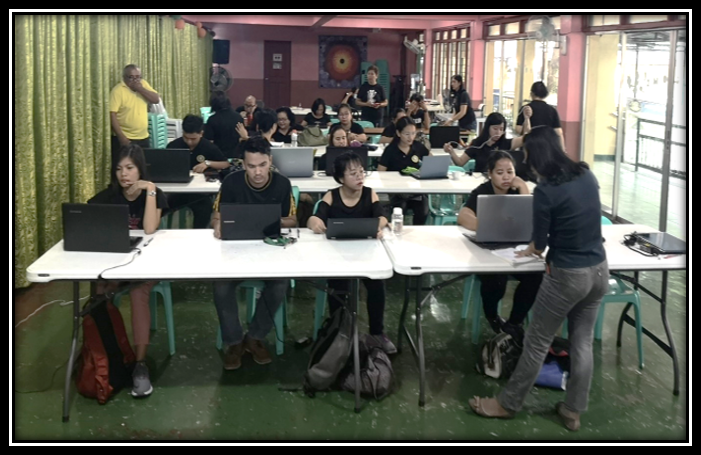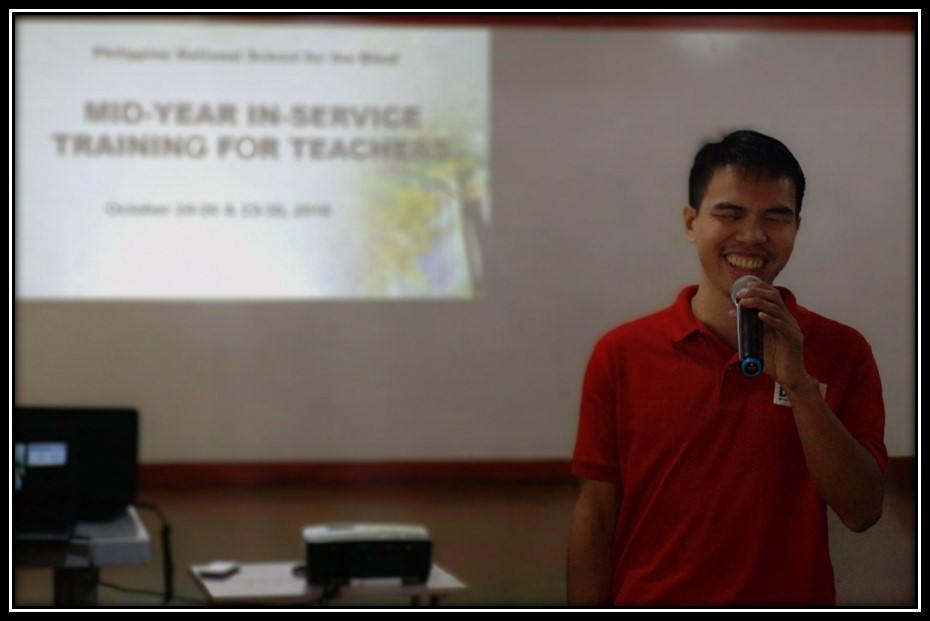PNSB’s Semestral In-Service Training adopts new way of producing instructional materials for its learners with visual impairment
INSET DAY 1
PNSB teachers adopts the use of Unified English Braille
For the past decades, learners with visual impairment and teachers alike has been using the English Braille American Edition as the primary system for reading and writing Braille. Until on November 2012 when the Braille Authority of North America (BANA) adopted the use of Unified English Braille that UEB became the new trend in Braille system.
Today’s INSET highlights the beginning of a new journey towards UEB as PNSB’s 29 teachers especially the new ones will undergo an extensive enrichment training workshop on using the Unified English Braille.
UEB has been now the official and implemented code for Braille in most countries all around the globe. Therefore PNSB teachers must equip themselves on the changes in UEB primarily the rules and principles governing the new Braille code.

To achieve this, Sir Ronald M. Manguiat, English teacher in the Junior High School and is blind himself piloted the training workshop. Mr. Manguiat is a UEB virtuoso who trained Special Education Teachers handing learners with visual impairment studying in mainstream classes.
UEB is not a totally new code; it is based on the current literary Braille code that has been modified in order to make transcribing from print to braille and vice versa become rather easier. it was developed to remove any ambiguity and confusion in using Braille especially for students with visually impairment. It is designed to “follow print” which means that whatever you see in print is also what you’ll see in Braille which is not the case in English Braille American Edition.
Mrs. Corazon B. Salvador understands that embracing changes is never easy; with this, she boosts her teachers’ morale and admonished them to fully commit themselves and empty themselves of all qualms and hesitations in learning UEB. More so challenged them to become competent in employing UEB and finish the course successfully.
For It is anticipated that over the next few years Unified English Braille will slowly but surely replace the American English Braille. And teachers who are catering to this disability are expected to utilize UEB in their everyday teaching so that they can gradually cascade it among their learners in the days to come.
Sir Ronald began his lecture-workshop with a pre-test on Braille transcribing. After which, he gave an insightful introduction of the UEB. Then he continued on and discussed the fundamentals of Braille Coding System. He emphasized on three basic principles. These are the principle of coding formations system or the basics dot configuration, the roots and the prefixes. In addition, he also discussed the English braille contractions that are no longer used in UEB to eliminate ambiguity.
These are just a few changes the Braille system undertook during the past 6 years. Other changes will be discussed and elaborated by our UEB resource person, Sir Ronald Manguiat on the coming days.
INSET DAY 2
A walk-through School related policies, guidelines and procedures
The second day of INSET is full-packed with significant and relevant school standards, guidelines, and procedures that are memorandized and supported by laws. ALL teaching and non-teaching employees of DEPED are expected to abide by with strict compliance. These are the following: Child Protection Policy, Code of Ethics for Professional Teachers, Review on the Modified School Forms, Personnel Actions.
The first session talked about Child Protection Policy. It was an immense topic expounded by Ms. Sheina T. Cadavos, School Guidance Counselor. She emphasized that the child must at all times feel safe and protected inside the school. Bullying, harassment, and any form of abuses committed on a learner will never be tolerated. If a teacher violates any that is stipulated on Child Protection Policy shall take her case to the region, and if the offender is a non-teaching, the case will be brought to the division.
Finally, the school CPFC committee was introduced; their roles and functions were likewise cited. This session was culminated by an open forum which gave room for questions and clarifications on the topic.
The next session was a talk about the Code Ethics for Professional Teachers which was presented by Mrs. Gemma

Soriano, President of the Faculty and Personnel Club (FPC).
This session was illustrated through discussion and group activities presentations that exhibit the ethics that professional teachers must possess. The topic began with the Preamble then went thru every Articles ensuring that everyone knows and understands the law because one important legal principle says that “Ignorance of the law, excuses no one”. It was a mind-nourishing activity that reminded everyone of their professional ethics and responsibilities firstly to oneself and your professional development, to the learners, school, and the community. This session was concluded by a thoughtful reflection on the professional ethics expected to school employees such as the teacher.
The last session conducted in the morning was the review of the modified school forms, LIS, and the EBEIS. This session was presented by Ms. Larnie Lebuna, LIS/EBEIS coordinator. She went through each form one-by-one thoroughly
discussing the use of each form and when and who should accomplish each form. Department Heads, and teachers, particularly the advisers realized the huge role they play for effective data gathering and recording in accomplishing LIS and EBEIS data. The session was closed with an earnest request to be patient in collecting pertinent documents of learners and to be prompt in accomplishing and submitting forms.
In the afternoon, another essential topic was discussed that is of great interest to all PNSB employees; the “Personnel in Action”. This session was delivered by Mrs. Merry Ann Santelices, Administrative Officer IV and Mrs. Janice Villaro, School Accountant. This session ensures that all personal are well aware of their benefits, leave and absences policies, job competencies, as well as the requirements for hiring and promotion of teachers, and salary step increments. The session was concluded with a forum where employees’ concerns were addressed accordingly.
Overall, the day of our INSET was indeed a fruitful one. It was informative and was altogether relevant that all school-bound employees must keep in mind. And now, it is at our disposal to practice and observe accordingly.
INSET DAY 3
PNSB Teachers Created an Accessible Audio File for their Visually Impaired Learners
In today’s INSET, PNSB teachers learned the technology behind DAISY under the tutelage of Ms. Larnie Lebuna who was trained in creating DAISY books.
Ms. Lebuna commenced her talk by introducing the DAISY (Digital Accessible Information System) technology, what does it do, and how do you create DAISY formatted files. She said that DAISY allows people with print disability such as people with dyslexia and visual impairment to access print materials in audio format. The created audio can be played using DAISY compatible software or players.
After understanding what DAISY is used for, Ms. Lebuna guided the teachers on how to set some configurations on one’s computer in order to make DAISY files. This includes installing JAVA, JAWS, and Save As DAISY add-ins in MS Word.
Before proceeding with the actual creation of DAISY file, the teachers first listened to a sample DAISY formatted audio read aloud in English and Filipino. After listening to the audio, teachers perceived that it was a commendable alternative tool to be used for learners who are still learning to use Braille. Apparently, there are lots of them in our school: They are those who come from mainstreamed school and transferred at PNSB.

So how do you make DAISY file then? Creating DAISY can be done in 6 easy steps. (1) Open the file, (2) Format it, (3) Run it for Validation, (4) Save it as DAISY, then (5) Translate the file and lastly, (6) open the file in FS Reader.
The hallmark of DAISY is that you both have the print and audio in one package. You can
navigate thru the file using simple keystrokes like pressing H for headings, and P for paragraph. You can also control its reading speed and choose the person who will read the audio whether male or female. More so you can have the file on your mobile and play it using a mobile reader that can be downloaded for free.
With the advent of DAISY, there’s a way to convert text to audio that is not compromising the file’s formatting, and most of all, its portable and handy to use.
INSET DAY 4
Making the Transition Form English Braille to UEB
Once again, PNSB teachers devoted their entire day today learning the new UEB code with Mr. Ronald Manguiat. This was the second session on the 3-day training workshop in learning the UEB. Mr. Manguiat continued his lecture and workshop elaborating the changes that takes place in English Braille code and that are currently in UEB. One examples of alterations made are the creation of indicators for letter, word, passage, and their respective termination indicators. The numeric mode, grade 1 mode and Grade 2 mode.
Mr. Manguiat began the day by reviewing the general rules discussed on the first-day of the UEB session. Then he proceeded on by conducting a group work on transcribing print text to UEB codes. After this task, Sir Ronald expounded the other modifications in UEB. He emphasized the indispensable role of the letter, word, and passage indicators on stand-alone signs, for if use properly would take away ambiguity when reading braille. In addition to this, he likewise pointed out that indicators must be paired with specific terminators. These termination indicators alert the readers to the fact that the letter, word, or a passage had ended
For numeric codes, Mr. Manguiat discussed the modifications that were now used for number code rules. Furthermore, He elaborated the difference between Grade 1and Grade 2 mode of Braille, and how they should be used and not to use.
At the end of the day, teachers somehow were able to demonstrate a clear understanding on how to apply the UEB rules accordingly.
INSERT DAY 5
UEB Milestones Unleashed
The last day of the INSET training was a fulfilling one. The day was a continuation of the UEB training. Teachers learned about the changes made in some contractions, punctuations, and typeforms. For example, in some contractions (shortened words) have been dropped at least nine of them. There are also changes in in the code of some punctuations, and there are now different indicator sign for boldface, italic, and underline font styles.

UEB make it much easier to accurately translate documents from braille to print. For instance, the contractions “and, for, and the” in UEB, these words are now separated by spaces rather than being placed together without a space as they currently are in the English braille code.
Why is it changed in UEB? One reason for this is that those words are separated by spaces in print, and therefore should be separated in braille as well.
Teaching Braille for many years, these changes are not that easy to learn, at least not all at once. However, with strong willingness, and being intentional in learning, it could be achieved.
Who will benefit from these changes? Those who will benefit most from the new code are the learners using the UEB—none other than our learners with visual impairment.
